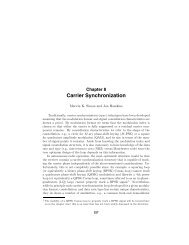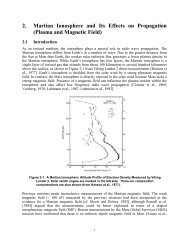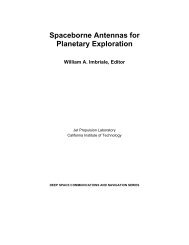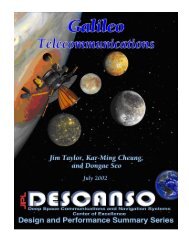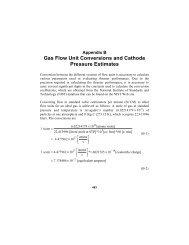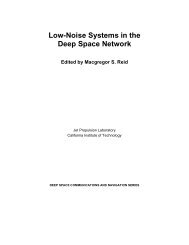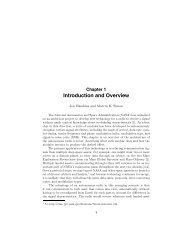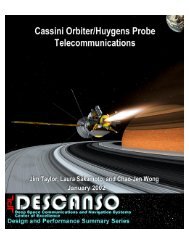Propagation Effects Handbook for Satellite Systems - DESCANSO ...
Propagation Effects Handbook for Satellite Systems - DESCANSO ...
Propagation Effects Handbook for Satellite Systems - DESCANSO ...
Create successful ePaper yourself
Turn your PDF publications into a flip-book with our unique Google optimized e-Paper software.
Washington, D.C. should on the average expect one maximum 5-minute<br />
fade each year, one maximum 10-minute fade every three years, etc.<br />
6.3.5.2 Annual and Daily Temporal Distribution of Intense Rain<br />
Events. The temporal distribution of rain-induced fade events can<br />
be important to a designer since loss of a link during low<br />
utilization periods may be tolerable. Figure 6.3-16a shows the<br />
distribution, by season, of “record” rainfall events at 207 weather<br />
stations throughout the U.S. The events are measured in terms of<br />
depth-duration, which specifies the total number of inches of rain<br />
and the time over which it fell. The durations are shown in the<br />
figure, and range from 5 minutes to 24 hours. Figure 6.3-16b shows<br />
the distribution of the maximum events by the times when they start.<br />
It is clear that the short-duration events, having the most intense<br />
rain (and the deepest fades) occur predominantly in the summer<br />
months and during the afternoon hours. There are regional<br />
variations of course: throughout much of the west coast, summer<br />
rains are insignificant. In the xnidwest, nocturnal thunderstorms<br />
are common. The figure also shows that more than 40% of the record<br />
24-hour rainfall events happen in the fall, when steady strati<strong>for</strong>m<br />
rains are the rule. The regional variations in the time<br />
distribution of heavy rains is clearly shown in Figure 6.3-17<br />
(Rasmussen- 1971). It gives the time of day of the maximum<br />
thunderstorm frequency, based on 10 years’ observations. A<br />
phenomenon not indicated by the map is the existence of secondary<br />
peaks in thunderstorm frequency in many regions.<br />
6.3.6 Rate of Change of Attenuation<br />
Experimental data related to the rate-of-change of attenuation<br />
is relatively sparse. Apparently experimenters have not analyzed<br />
their measurements to obtain this in<strong>for</strong>mation except during some<br />
extreme attenuation occurrences. Some measurements made at Rosman,<br />
NC of the CTS 11.7 GHz beacon showed a maximum rate-of-change of 2<br />
dB/sec on April 24, 19-7 (Ippolito-1979). This translates to change<br />
of rain rate from 50 n nr to 57 mm/hr in ne second. Assuming this<br />
6-56<br />
-,





